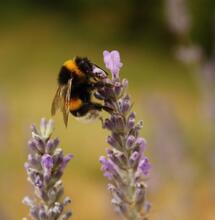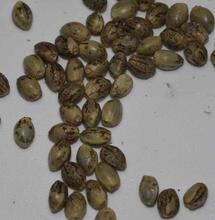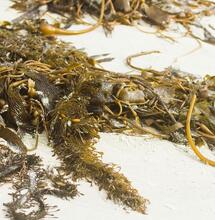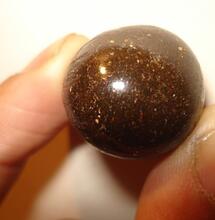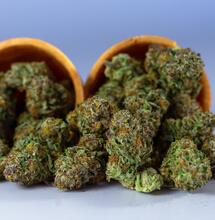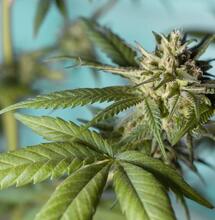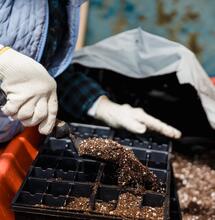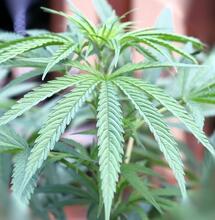Cannabis Botany Terminology for Beginners: Part II
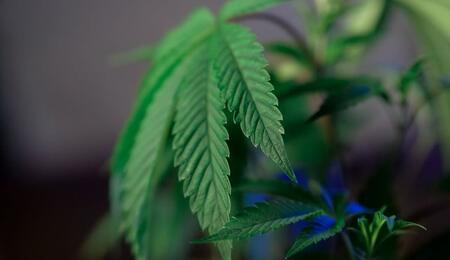
Learning basic botanical Cannabis terminology is the easiest way to begin to understand the plant and its related structures and functions. In this installment, we conclude our list of typical Cannabis botany terms, helping you to get the most from your marijuana education. Keep checking back for glossaries of helpful medical terms, cultivation phrases, hash or concentrate terminology and more.
Ovule
A plant part containing the embryo sac and female haploid (1n) gamete germ cell. This structure is where seeds grow in pollinated female Cannabis plants. A calyx surrounds the ovule and pistils.
Palmate
Cannabis leaves naturally grow in a pattern of odd-numbered 'fingers', resulting in the appearance of a hand-like or palmate structure.
Petiole
The tiny leaf stalk (at the base of each leaf blade) that attaches and supports the leaf blade at the stalk; the first petioles of the 'true' leaves, which look like typical, serrated Cannabis leaves, are located a quarter-turn in orientation from the cotyledons of a seedling. Inflorescence begins at the intersection of the leaf petioles.
Phenotype
While the genotype reveals the genetic code or set of information for a particular plant, the phenotype is the outward expression of the traits contained therein. For example, a plant may be short, dark green and bushy with thick, heavy flowers, which is a different phenotype from one that is tall, graceful and thin, with slender leaves and delicate flowers.
Pistil
In botany, the pistil is the female reproductive portion of a flower, technically the ovule-bearing or seed-bearing female organ and referring to the combination of style, stigma and ovule. Pistils first appear at the internodes as a delicate, v-shaped pair of almost fuzzy-looking 'hairs' upon which the trichomes or resin glands grow; these hairs flourish along with calyces and together comprise the female Cannabis inflorescence that is consumed for medicine or recreation. If pistils show at the pre-flowering stage, the plant is female.
Pollen Sacs
The male staminate Cannabis flowers are comprised of pendulous, five-petal calyces. From these, five stamens appear, consisting of anthers or pollen sacs suspended by thin filaments. These anthers are capable of releasing thousands of pollen grains, which are wind- or animal-transferred in nature or intentionally collected and applied to certain female flowers in order to create specific strains.
Racemes
Racemes are non-branched, indeterminate inflorescence that bear pedicillate flowers (those attached by short flower stalks, called pedicels) along the axis. The older flowers are typically located towards the bottom of the raceme, with newer flowers sprouting as the shoot grows. In Cannabis, this action elongates the flower into a large cola, which may reach a foot or more in length.
Ruderalis
A subspecies called Cannabis ruderalis originated in Russia but flourishes across Northern and Eastern Europe and even Canada. Ruderalis tends to be shorter and flower faster than either indicas or sativas; in addition, it is prone to pre-flowering, growing and flowering at the same time, regardless of photoperiod. Some of these genes were combined with smoke-able Cannabis genetics in order to create what are now known as 'auto-flowering' varieties. These strains are typically grown for a quick, commercial harvest, rather than as protected genetics or A-grade smoke.
Sativa
A species of the family Cannabaceae and member of the Cannabis genus, Cannabis sativa is the most commonly-known weed. Sativa varieties are tall and slender, with delicate flowers, and originate in hot climates that have long photoperiods or growing seasons. Although these take more time to flower than the indicas, sativas are sought after for the high, happy feeling that they impart.
Seeds
When a female Cannabis flowers is pollinated, its cannabinoid production and content changes and the fertilized ovule produces a seed. Cannabis seeds, the fruit of the plant, are actually 'achenes' or nuts, as their center is surrounded by a smooth, hard shell. Hemp seeds have been used as a nutritious source of protein and essential fatty acids (EFAs) for thousands of years.
Sinsemilla
Spanish for 'without seeds', sinsemilla Cannabis flowers are preferable for several reasons. Firstly, as mentioned above, female flowers that have not been pollinated produce the highest quality drug experience. When flowers have been pollinated, the plant's energy is re-directed towards producing cannabinoids that protect it, which tend to have a less pleasant effect and strength. In addition, many smokers prefer not to have to remove the seeds before using the product, which is necessary as it is not healthy to smoke Cannabis achenes.
Stamen
The male reproductive organ of a Cannabis flower is known as a stamen, which consists of a stalk or filament that bears a pollen-producing anther.
Strain
A strain is a specific type or variety of Cannabis plant. Some strains are selected because of their flavor or effect, while others might be chosen simply due to their high yield or short flowering time.
THC
Short for tetrahydrocannabinol, THC is perhaps the most well-known of all cannabinoids, the active ingredients in the trichomes or resin glands on Cannabis flowers. This cannabinoid is found in larger concentrations in the sativa and haze varieties, which impart a high, happy feeling when inhaled. THC treats a range of ailments from depression to asthma and is mostly concentrated in the trichomes of female Cannabis flowers, but male flowers also contain trichomes.
Trichome
A trichome is a mushroom-shaped resin gland that changes from opaque white to clear and amber as the plant flower matures. Trichomes are filled with Cannabis resin, which contains active and inactive cannabinoids and is extracted in a variety of ways to produce hashish. Resin glands protect the flower by trapping winged predators and the cannabinoids therein function as plant poisons, while the stickiness also aids the plant in wind pollination.
Vegetation
When growing indoors, gardeners recreate the two cycles of Cannabis plant development - growth or vegetation and the flowering phase. When a plant is 'in veg', it is receiving eighteen hours of light at a blue spectrum; this represents optimal springtime growing conditions. A vegetating plant is focused upon growth, whereas a flowering plant produces the inflorescence for seed development (if the plant becomes pollinated and fertilization occurs.) Vegging plants are healthy and green and do not usually have any visible flowers.
Yield
Upon harvesting, the amount of dried Cannabis flowers produced by a particular strain is referred to as its yield. Some varieties have a very high yield but the flavor and effect may be lacking; these strains are typically grown in large-scale operations and considered commercial Cannabis. Lower-yielding varieties might be cultivated in order to preserve genetics or because, in spite of their lower output, they may contain highly desirable traits such as a pure or very strong effect or unusual flavor.
More on this topic from Soft Secrets:
